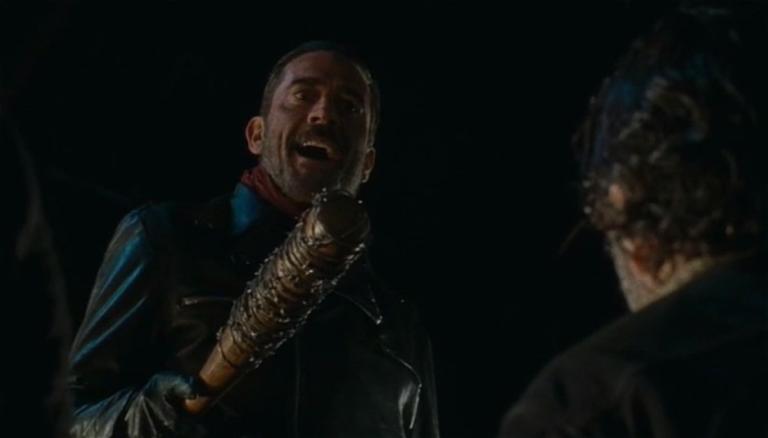(Warning: spoilers for the most recent season of The Walking Dead.)
Over the past week and a half social media has been ringing with complaints about the cliffhanger season finale of The Walking Dead, specially about how…
(Spoiler warning again…)
…we’re not shown which major character is killed by the newly introduced big villain Negan. There’s even an on-line petition to make AMC air some sort of mini-episode over the summer to let us know who died. As this reveal hasn’t yet been filmed, this petition is basically yelling at the sky.
One wonders how these fans would have reacted to the great television cliffhangers of the past, like Dallas’s who shot JR, or The Simpsons spoof of that with who shot Mr. Burns, or the Borg assimilation of Star Trek: The Next Generation‘s Captain Picard
But then, in those days the meta-narrative landscape was different. We didn’t have fan websites, or behind-the-scenes shows like Talking Dead. What’s amazing about these complaints is that they emerge from these auxiliary elements. If one only watched the show and didn’t know about the side discussion, there was no definite “someone is going to die” arc in the story itself and no expectation about which to be disappointed. Most of the upset is not about what happened in the episode itself but about the expectations fans had developed from interaction with the creators outside of the show itself.
This sort of meta-narrative interaction can be traced back through Babylon 5 creator J. Michael Straczynski’s use of USENET, GEnie, and CompuServe message boards in the 1990s to comic book letters columns in the 1960s and 70s, all the way back to Charles Dickens being influenced by reader reaction to make changes along the way to his serially-published novels. But it has taken on a whole new importance in the age of social media. It will be interesting to see how the balance eventually settles out, whether fiction will devolve into a tight loop of short-term fan gratification or whether authors will be able to benefit from fan feedback while maintaining their vision.
And this case is ironic because it is a horror audience complaining about being kept in suspense. Horror might be defined as the subgenre of speculative fiction that sets out to disturb the emotions in order to investigate the boundaries of the human condition. As F. Paul Wilson wrote in his introduction to Sandman: Preludes and Nocturnes, the first collection of Neil Gaiman’s ground-breaking Sandman,
Anybody can splatter you with blood and other sundry precious bodily fluids. But they wash off, don’t they? Just like mud. Just like spilled food and drink. Wash right off yours skin without leaving a trace of their passing. Not the good stuff, though. Good horror gets past the skin. It seeps through and insinuates its way into the tissues, invades the circulation, spreads to all the vital organs, contaminates the nervous system, taking up residence behind the eyes so that nothing looks quite the same again. Ever.
In other words, you are supposed to be upset. Disturbed. Displaced and discomforted.
Now I don’t mean to say the episode was great horror or great television. I think it ultimately goes in the books as a win but there were problems with pacing and with the way the B story with Morgan and Carol was interleaved. The whole subplot with Carol sickening of killing after burning a bunch of Saviors to death in a cold-blooded ambush even as Morgan realizes the limits of naive pacifism, both of them wrestling with the fact that caring for people means being willing to do whatever it takes, even killing, to protect them, deserved a much deeper exploration — at least as deep as the episode we spent on his transformation from bestial killer to Kwai Chang Caine-like martial arts master. (As someone who tries to promote peace even as I teach people to protect themselves using means up to and including lethal force, the dilemma that Carol and Morgan have been playing out kind of hits me where I live.)
So I have sympathy with those who say that the episode’s flaws reduced their interest in what ultimately happened to our protagonists.
But specifically, the complaint that “we don’t know who Negan selected to be his victim” strikes me as ill-founded. We should be disturbed and upset, and we should be looking at at that upset and what it says about us. Are we more worried about who died than that someone died? Are we keeping in mind that “any man’s death diminishes me” or are we hoping that it was the sometimes annoying Eugene and not the kick-ass Michonne who was killed? Speaking of which, are there gender or racial elements involved in shaping our hopes about who survived? Is it more horrible if a woman is murdered than if a man is? In this time of #BlackLivesMatter is it more horrible if an African-American character is killed? I don’t mean to suggest answers to any of these questions; I mean that if you find yourself having a strong reaction to them, that’s the point.
There are a whole bunch of deeply upsetting questions we could be asking ourselves in the suspense of who died. Making us consider them is the job of a good horror story. Again, we may conclude that this isn’t a good story, that it fails to accomplish this; but I think faulting the show for leaving a space for that suspense misses the point of the genre. (Perhaps some of these angry fans might be happier watching soap operas.)
Coincidently, the same day that the finale aired Nature published online a paper on how human sacrfice has been used in many cultures to reinforce social hierarchy and stratification. It’s interesting because the episode shows us or mentions the deliberate murder of three people by the Saviors, all killed as a means of maintaining their power and cowing possible resistance. We have the man who is running away and caught and beaten at the beginning of the episode, who later is hanged as an example to the Alexandrians; a man who is said to have been hanged earlier at the library, who becomes the walker that Morgan cuts down; and the unknown victim at the end.
So another thing the episode leads us to consider is the role of violence in establishing and maintaining the social order. This is what true terrorism looks like — not an asymetrical war of resistance that violates the rules of polite fighting but a constant threat of arbitrary violence from the top of the hierarchy. And it doesn’t look all that different, at root, from examples we’ve seen recently in the news of how the modern state uses what amounts to human sacrifice — the highly public killings of selected individuals — in an attempt to maintain power and order, from murdering people in Pakistan with drones missile strikes to executing a mentally disabled man convicted by a jury tainted by racism.
The modern state is a little more subtle than Negan and his Saviors, but whether it’s a barbed-wire-wrapped baseball bat to the head, a Hellfire missile turning human bodies into a fine pink mist, or a needle injecting poison into a man’s veins to suffocate him, may not make much difference to those killed or to those cowed by the exhibition of power. And that’s another horrible and disturbing thing about real life that we can mull over while we wait to find out what happened in this bit of fiction.
You can keep up with “The Zen Pagan” by subscribing via RSS or e-mail.
Have I mentioned my book lately? Now that you’ve got an hour free on Sunday evenings for a few months maybe you could spend the time reading Why Buddha Touched the Earth. Or buy a copy now for beach or poolside reading this summer.
If you do Facebook, you might choose to join a group on “Zen Paganism” I’ve set up there. And don’t forget to “like” Patheos Pagan and/or The Zen Pagan over there,
too.














